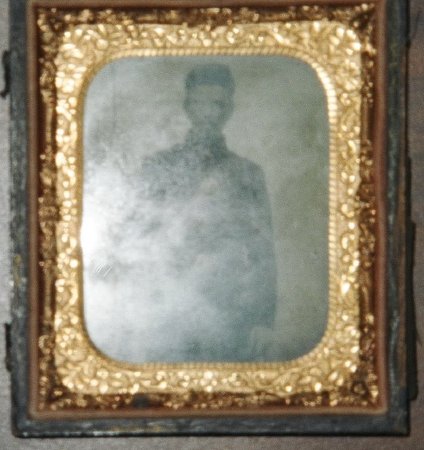Credit Line:
Peoria Historical Society Collection
Description:
Ambrotype with a photo of a Civil War soldier, Lemuel Shook. Lined in red velvet, gold matte frame edged with velvet, raised design on outer area. Two metal hoops on each side.
Lemuel Shook was born 1836—37 in Indiana and buried in Springdale Cemetery, grave 29, Lot 2737, Tr. 8, lower bluff, has government headstone. Was in Company E, 103rd ILL. Infantry. Entered service August 4, 1862, detached at Muster out of Regiment. Belonged to GAR Post 67. Enlisted at Banner, Illinois. Obituary is in GAR Record book, page 75. His wife died in 1909.
Lemuel Shook was born 1836—37 in Indiana and buried in Springdale Cemetery, grave 29, Lot 2737, Tr. 8, lower bluff, has government headstone. Was in Company E, 103rd ILL. Infantry. Entered service August 4, 1862, detached at Muster out of Regiment. Belonged to GAR Post 67. Enlisted at Banner, Illinois. Obituary is in GAR Record book, page 75. His wife died in 1909.
Dimensions:
W—9.5 L—9.5 cm
Object ID:
1111.8.1
Object Name:
ambrotype
VE Exhibit Label 1:
Lemuel Shook was born 1836—37 in Indiana and buried in Springdale Cemetery, grave 29, Lot 2737, Tr. 8, lower bluff, has government headstone. Was in Company E, 103rd ILL. Infantry. Entered service August 4, 1862, detached at Muster out of Regiment.
VE Exhibit Label 2:
testing
VE Exhibit Label 3:
The ambrotype (from Greek: ??ß??t?? — “immortal”, and t?p?? — “impression”) or amphitype is a photograph that creates a positive image on a sheet of glass using the wet plate collodion process. In the United States, ambrotypes first came into use in the early 1850s. The wet plate collodion process was invented just a few years before that by Frederick Scott Archer, but ambrotypes used the plate image as a positive, instead of a negative. In 1854, James Ambrose Cutting of Boston took out several patents relating to the process and may be responsible for coining the term "ambrotype".[1]
In the United Kingdom it was called collodion positive: one side of a very clean glass plate is covered with a thin layer of collodion, then dipped in a silver nitrate solution. The plate is exposed to the subject while still wet. (Exposure times vary from five to sixty seconds or more depending on the amount of available light.) The plate is then developed and fixed. The resulting negative, when viewed by reflected light against a black background, appears to be a positive image: the clear areas look black, and the exposed, opaque areas appear light. This effect is achieved by coating one side of the glass negative with black varnish. Either the emulsion side or the blank side can be covered with the varnish: when the blank side is blackened, the thickness of the glass adds a sense of depth to the image. In either case, another plate of glass is put over the fragile emulsion side to protect it, and the whole is mounted in a metal frame and kept in a protective case. In some instances the protective glass was cemented directly to the emulsion, generally with a balsam resin. This protected the image well but tended to make it darker.
The ambrotype was much less expensive to produce than the daguerreotype, and it lacked the daguerreotype's shiny metallic surface, which some found unappealing. By the late 1850s, the ambrotype was overtaking the daguerreotype in popularity; by the mid—1860s, the ambrotype itself was supplanted by the tintype and other processes.
Ambrotypes were often hand—tinted. Untinted ambrotypes are grayish—white and have less contrast and brilliance than daguerreotypes.
In the United Kingdom it was called collodion positive: one side of a very clean glass plate is covered with a thin layer of collodion, then dipped in a silver nitrate solution. The plate is exposed to the subject while still wet. (Exposure times vary from five to sixty seconds or more depending on the amount of available light.) The plate is then developed and fixed. The resulting negative, when viewed by reflected light against a black background, appears to be a positive image: the clear areas look black, and the exposed, opaque areas appear light. This effect is achieved by coating one side of the glass negative with black varnish. Either the emulsion side or the blank side can be covered with the varnish: when the blank side is blackened, the thickness of the glass adds a sense of depth to the image. In either case, another plate of glass is put over the fragile emulsion side to protect it, and the whole is mounted in a metal frame and kept in a protective case. In some instances the protective glass was cemented directly to the emulsion, generally with a balsam resin. This protected the image well but tended to make it darker.
The ambrotype was much less expensive to produce than the daguerreotype, and it lacked the daguerreotype's shiny metallic surface, which some found unappealing. By the late 1850s, the ambrotype was overtaking the daguerreotype in popularity; by the mid—1860s, the ambrotype itself was supplanted by the tintype and other processes.
Ambrotypes were often hand—tinted. Untinted ambrotypes are grayish—white and have less contrast and brilliance than daguerreotypes.
VE Exhibit Label 4:
testing
Objects Field 01:
103rd Illinois Infantry Regiment Company E
Subjects:
Civil wars
Soldiers
Photographs
Soldiers
Photographs
Source:
Shook Cook, Mildred
People:
Shook, Lemuel
Old#:
A 195—2
Material:
leather, wood, metal, glass, paper, velvet
Category:
8: Communication Artifact
Accession#:
1111.8
